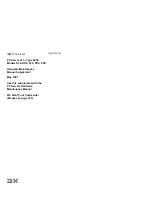
System Overview 1-25
!
DEU with additional hot-swap SCSI hard disk drive bays for mounting up to eight
SCSI hard disk drives in easily removable drive carriers. Each drive has a set of
three lights to indicate the fault or other status: power-on (green LED), activity
(green LED), and fault (yellow LED).
Disk Array
The optional disk array controller board is a PCI board (standard on tower-based
systems) that improves data reliability. The disk array controller board allows the hard
disk drives in the SCSI hard disk drive bays and additional optional disk expansion unit
to support disk array configuration RAID levels 0, 1, and 5.
RAID is an acronym of “Redundant Arrays of Inexpensive (Independent) Disks”. It
logically integrates several hard disks to appear to the system as only one disk drive.
Using the disk array method, the large-capacity hard disk can be configured with
several inexpensive and small-capacity hard disks. It can also enhance the drive by
improving the reliability and supporting an automatic rebuilding function.
All RAID levels are common in their basic operation due the fact that several hard disks
can be recognized as one disk drive. However, performance, cost, and use are
conditions that vary according to the RAID level. You should select an appropriate
configuration that is suitable for your system.
Features and selection examples of different RAID levels are shown below.
Level
Definition
Redund-
ancy
Feature
Suitable
application
Minimum
No. of disks
RAID0
Striping
No
Access: high-speed.
Application that
needs high
performance for
non-critical data
2
RAID1
Mirroring
(or shadowing)
Yes
Dual disk system.
Read mode: high-
speed
Write mode: slower
than RAID 0
Application that
needs to store
important files
on main system
drive
2
RAID5
Striped data
and parity
Yes
Parity data.
Transfers large
amount of data.
Write mode: slower
than RAID 0
Application that
needs to store
important data.
Application of
read-intensive
type
data searching.
3
This unit supports other RAID levels as well. However, it is not recommended to use
them unless absolutely necessary.
Summary of Contents for Express5800/180Ra-7
Page 1: ... U s e r s G u i d e EXPRESS5800 180Ra 7 ...
Page 2: ...xxx ...
Page 3: ... U s e r s G u i d e EXPRESS5800 180Ra 7 ...
Page 10: ...viii Contents ...
Page 94: ...3 28 Configuring Your System ...
Page 134: ...4 40 Upgrading Your System A B C Figure 4 43 Recabling the SCSI Interface Cable ...
Page 166: ...4 72 Upgrading Your System ...
Page 206: ...5 40 Problem Solving ...
Page 207: ...A Specifications Basic System Unit BSU Disk Expansion Unit DEU ...
Page 212: ...A 6 Specifications ...
Page 218: ...B 6 Interrupt Request PCI IRQ Device I O Port Address Assignments ...
Page 229: ...D ROMPilot BIOS Error Codes ROMPilot BIOS Error Codes ...
Page 232: ...D 4 ROMPilot BIOS Error Codes ...
Page 242: ...10 Glossary ...
Page 246: ...4 Equipment Log ...
Page 250: ...Index 4 ...
Page 251: ...xx ...
Page 252: ... 456 01516 000 ...
















































